Positive and Negative Impact of Stereotyping in Organisational Behaviour
VerifiedAdded on 2023/06/13
|8
|2379
|441
AI Summary
This essay analyses the impact of stereotyping in organisational behaviour and evaluates how it affects employees’ performance. It provides recommendations for minimising stereotyping at the workplace by using different organisational behaviour theories.
Contribute Materials
Your contribution can guide someone’s learning journey. Share your
documents today.
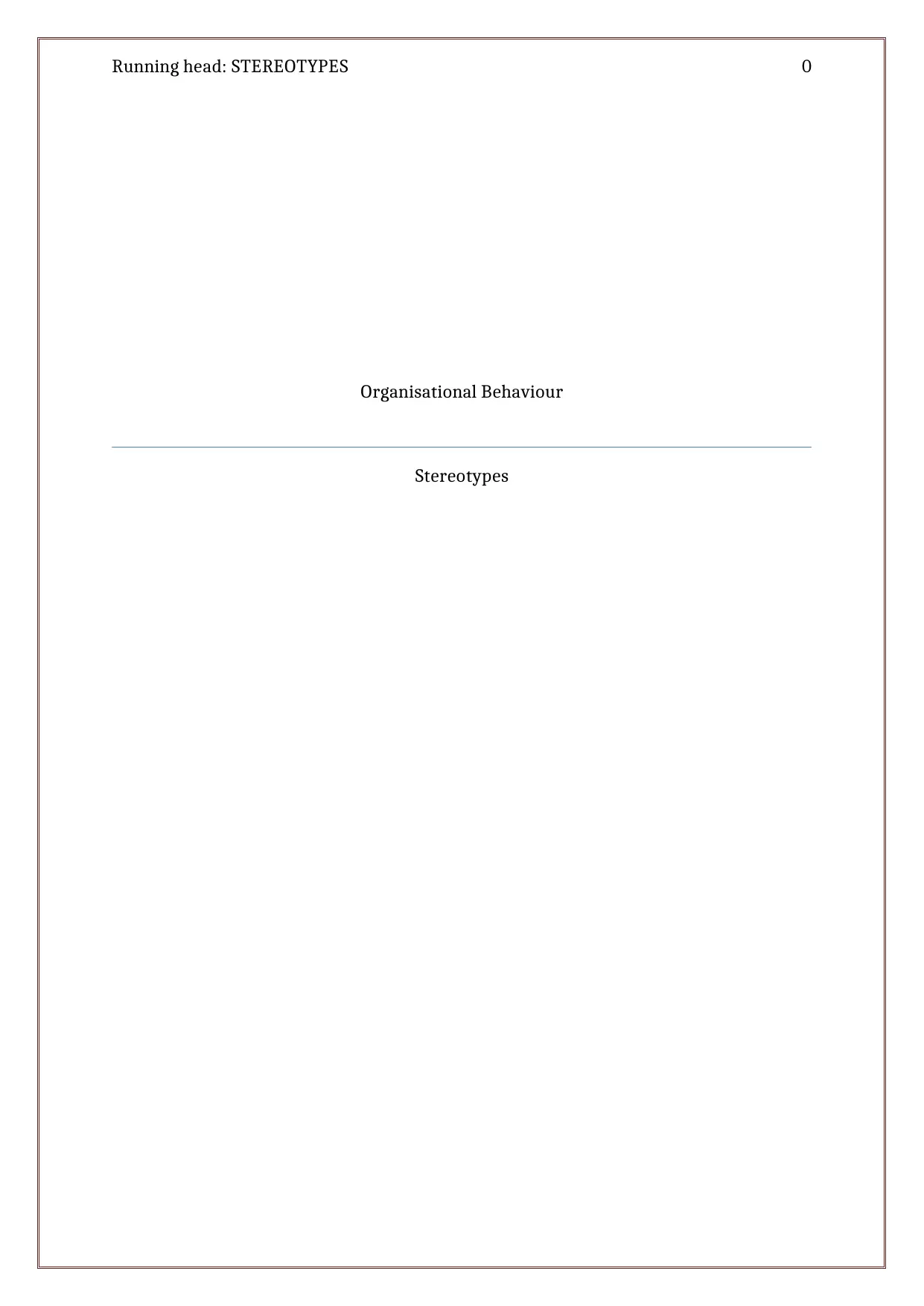
Running head: STEREOTYPES 0
Organisational Behaviour
Stereotypes
Organisational Behaviour
Stereotypes
Secure Best Marks with AI Grader
Need help grading? Try our AI Grader for instant feedback on your assignments.
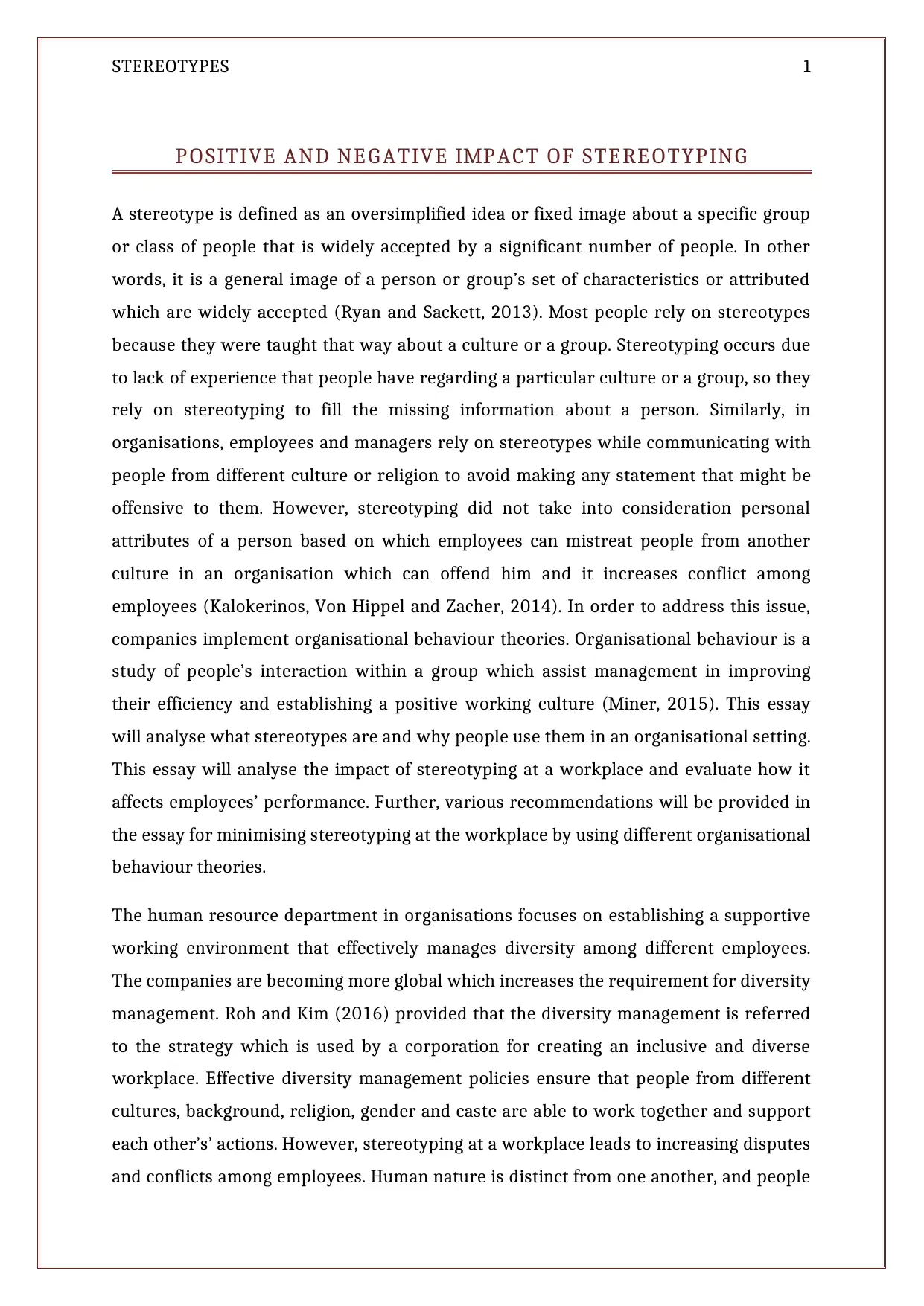
STEREOTYPES 1
POSITIVE AND NEGATIVE IMPACT OF STEREOTYPING
A stereotype is defined as an oversimplified idea or fixed image about a specific group
or class of people that is widely accepted by a significant number of people. In other
words, it is a general image of a person or group’s set of characteristics or attributed
which are widely accepted (Ryan and Sackett, 2013). Most people rely on stereotypes
because they were taught that way about a culture or a group. Stereotyping occurs due
to lack of experience that people have regarding a particular culture or a group, so they
rely on stereotyping to fill the missing information about a person. Similarly, in
organisations, employees and managers rely on stereotypes while communicating with
people from different culture or religion to avoid making any statement that might be
offensive to them. However, stereotyping did not take into consideration personal
attributes of a person based on which employees can mistreat people from another
culture in an organisation which can offend him and it increases conflict among
employees (Kalokerinos, Von Hippel and Zacher, 2014). In order to address this issue,
companies implement organisational behaviour theories. Organisational behaviour is a
study of people’s interaction within a group which assist management in improving
their efficiency and establishing a positive working culture (Miner, 2015). This essay
will analyse what stereotypes are and why people use them in an organisational setting.
This essay will analyse the impact of stereotyping at a workplace and evaluate how it
affects employees’ performance. Further, various recommendations will be provided in
the essay for minimising stereotyping at the workplace by using different organisational
behaviour theories.
The human resource department in organisations focuses on establishing a supportive
working environment that effectively manages diversity among different employees.
The companies are becoming more global which increases the requirement for diversity
management. Roh and Kim (2016) provided that the diversity management is referred
to the strategy which is used by a corporation for creating an inclusive and diverse
workplace. Effective diversity management policies ensure that people from different
cultures, background, religion, gender and caste are able to work together and support
each other’s’ actions. However, stereotyping at a workplace leads to increasing disputes
and conflicts among employees. Human nature is distinct from one another, and people
POSITIVE AND NEGATIVE IMPACT OF STEREOTYPING
A stereotype is defined as an oversimplified idea or fixed image about a specific group
or class of people that is widely accepted by a significant number of people. In other
words, it is a general image of a person or group’s set of characteristics or attributed
which are widely accepted (Ryan and Sackett, 2013). Most people rely on stereotypes
because they were taught that way about a culture or a group. Stereotyping occurs due
to lack of experience that people have regarding a particular culture or a group, so they
rely on stereotyping to fill the missing information about a person. Similarly, in
organisations, employees and managers rely on stereotypes while communicating with
people from different culture or religion to avoid making any statement that might be
offensive to them. However, stereotyping did not take into consideration personal
attributes of a person based on which employees can mistreat people from another
culture in an organisation which can offend him and it increases conflict among
employees (Kalokerinos, Von Hippel and Zacher, 2014). In order to address this issue,
companies implement organisational behaviour theories. Organisational behaviour is a
study of people’s interaction within a group which assist management in improving
their efficiency and establishing a positive working culture (Miner, 2015). This essay
will analyse what stereotypes are and why people use them in an organisational setting.
This essay will analyse the impact of stereotyping at a workplace and evaluate how it
affects employees’ performance. Further, various recommendations will be provided in
the essay for minimising stereotyping at the workplace by using different organisational
behaviour theories.
The human resource department in organisations focuses on establishing a supportive
working environment that effectively manages diversity among different employees.
The companies are becoming more global which increases the requirement for diversity
management. Roh and Kim (2016) provided that the diversity management is referred
to the strategy which is used by a corporation for creating an inclusive and diverse
workplace. Effective diversity management policies ensure that people from different
cultures, background, religion, gender and caste are able to work together and support
each other’s’ actions. However, stereotyping at a workplace leads to increasing disputes
and conflicts among employees. Human nature is distinct from one another, and people
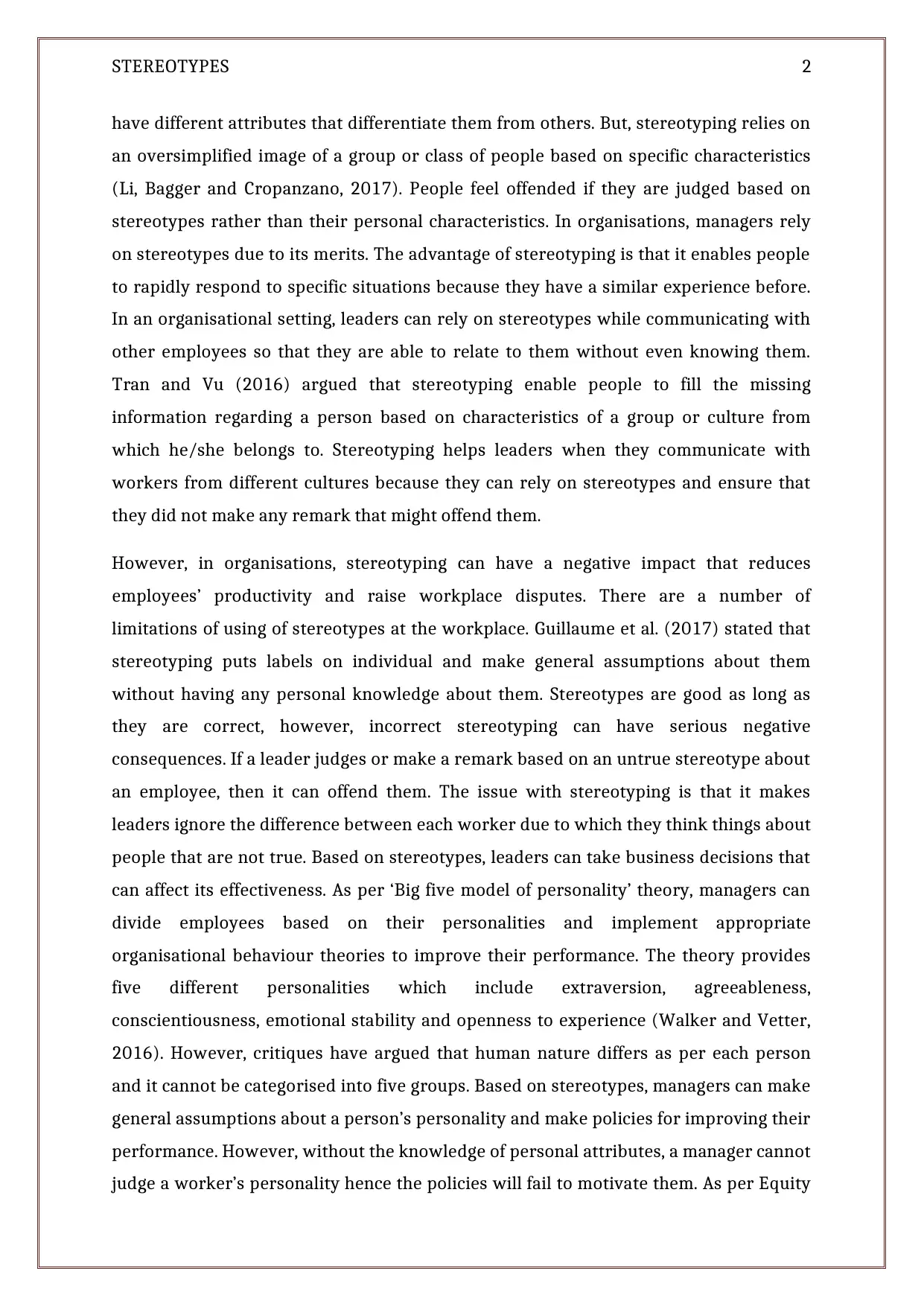
STEREOTYPES 2
have different attributes that differentiate them from others. But, stereotyping relies on
an oversimplified image of a group or class of people based on specific characteristics
(Li, Bagger and Cropanzano, 2017). People feel offended if they are judged based on
stereotypes rather than their personal characteristics. In organisations, managers rely
on stereotypes due to its merits. The advantage of stereotyping is that it enables people
to rapidly respond to specific situations because they have a similar experience before.
In an organisational setting, leaders can rely on stereotypes while communicating with
other employees so that they are able to relate to them without even knowing them.
Tran and Vu (2016) argued that stereotyping enable people to fill the missing
information regarding a person based on characteristics of a group or culture from
which he/she belongs to. Stereotyping helps leaders when they communicate with
workers from different cultures because they can rely on stereotypes and ensure that
they did not make any remark that might offend them.
However, in organisations, stereotyping can have a negative impact that reduces
employees’ productivity and raise workplace disputes. There are a number of
limitations of using of stereotypes at the workplace. Guillaume et al. (2017) stated that
stereotyping puts labels on individual and make general assumptions about them
without having any personal knowledge about them. Stereotypes are good as long as
they are correct, however, incorrect stereotyping can have serious negative
consequences. If a leader judges or make a remark based on an untrue stereotype about
an employee, then it can offend them. The issue with stereotyping is that it makes
leaders ignore the difference between each worker due to which they think things about
people that are not true. Based on stereotypes, leaders can take business decisions that
can affect its effectiveness. As per ‘Big five model of personality’ theory, managers can
divide employees based on their personalities and implement appropriate
organisational behaviour theories to improve their performance. The theory provides
five different personalities which include extraversion, agreeableness,
conscientiousness, emotional stability and openness to experience (Walker and Vetter,
2016). However, critiques have argued that human nature differs as per each person
and it cannot be categorised into five groups. Based on stereotypes, managers can make
general assumptions about a person’s personality and make policies for improving their
performance. However, without the knowledge of personal attributes, a manager cannot
judge a worker’s personality hence the policies will fail to motivate them. As per Equity
have different attributes that differentiate them from others. But, stereotyping relies on
an oversimplified image of a group or class of people based on specific characteristics
(Li, Bagger and Cropanzano, 2017). People feel offended if they are judged based on
stereotypes rather than their personal characteristics. In organisations, managers rely
on stereotypes due to its merits. The advantage of stereotyping is that it enables people
to rapidly respond to specific situations because they have a similar experience before.
In an organisational setting, leaders can rely on stereotypes while communicating with
other employees so that they are able to relate to them without even knowing them.
Tran and Vu (2016) argued that stereotyping enable people to fill the missing
information regarding a person based on characteristics of a group or culture from
which he/she belongs to. Stereotyping helps leaders when they communicate with
workers from different cultures because they can rely on stereotypes and ensure that
they did not make any remark that might offend them.
However, in organisations, stereotyping can have a negative impact that reduces
employees’ productivity and raise workplace disputes. There are a number of
limitations of using of stereotypes at the workplace. Guillaume et al. (2017) stated that
stereotyping puts labels on individual and make general assumptions about them
without having any personal knowledge about them. Stereotypes are good as long as
they are correct, however, incorrect stereotyping can have serious negative
consequences. If a leader judges or make a remark based on an untrue stereotype about
an employee, then it can offend them. The issue with stereotyping is that it makes
leaders ignore the difference between each worker due to which they think things about
people that are not true. Based on stereotypes, leaders can take business decisions that
can affect its effectiveness. As per ‘Big five model of personality’ theory, managers can
divide employees based on their personalities and implement appropriate
organisational behaviour theories to improve their performance. The theory provides
five different personalities which include extraversion, agreeableness,
conscientiousness, emotional stability and openness to experience (Walker and Vetter,
2016). However, critiques have argued that human nature differs as per each person
and it cannot be categorised into five groups. Based on stereotypes, managers can make
general assumptions about a person’s personality and make policies for improving their
performance. However, without the knowledge of personal attributes, a manager cannot
judge a worker’s personality hence the policies will fail to motivate them. As per Equity
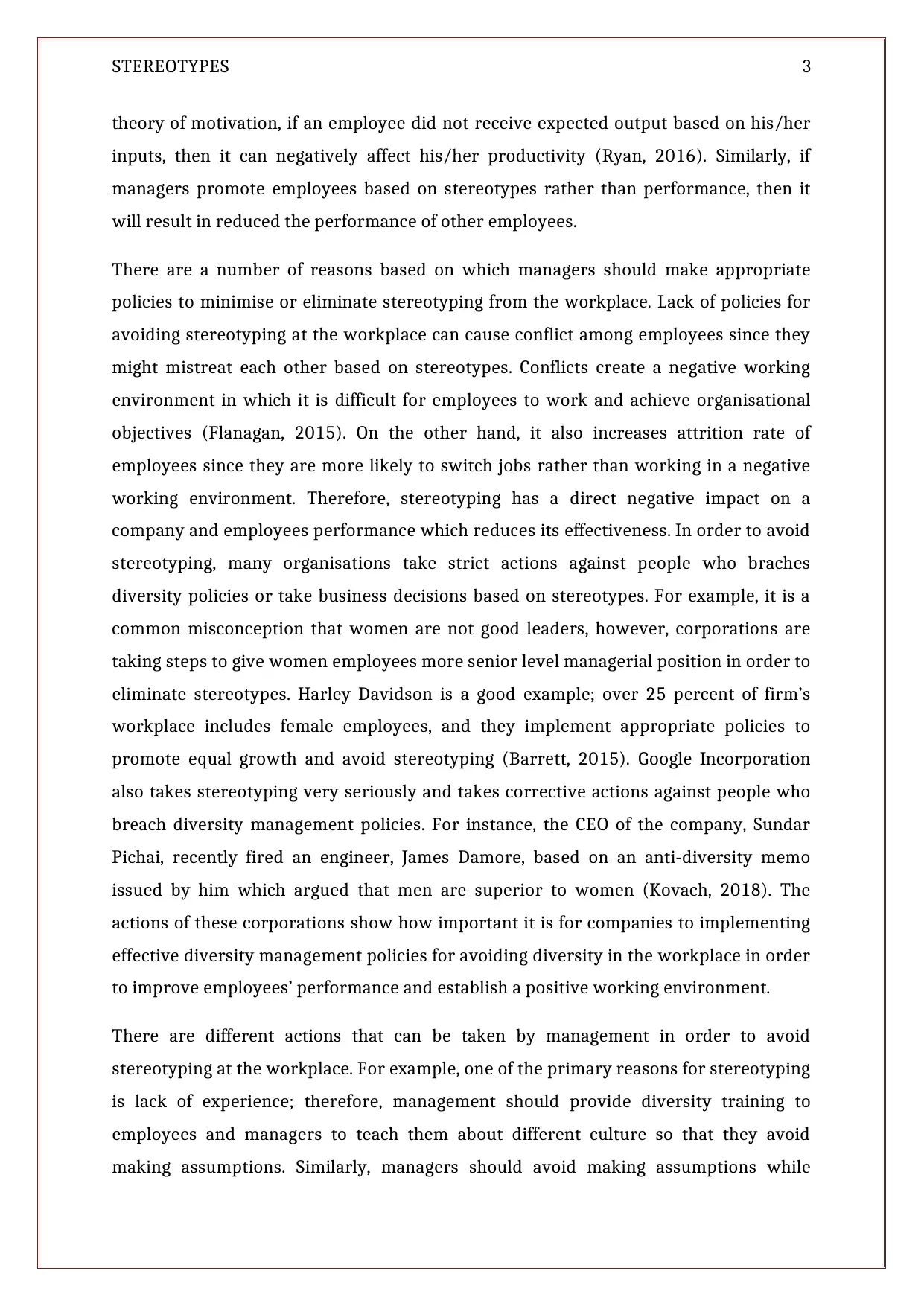
STEREOTYPES 3
theory of motivation, if an employee did not receive expected output based on his/her
inputs, then it can negatively affect his/her productivity (Ryan, 2016). Similarly, if
managers promote employees based on stereotypes rather than performance, then it
will result in reduced the performance of other employees.
There are a number of reasons based on which managers should make appropriate
policies to minimise or eliminate stereotyping from the workplace. Lack of policies for
avoiding stereotyping at the workplace can cause conflict among employees since they
might mistreat each other based on stereotypes. Conflicts create a negative working
environment in which it is difficult for employees to work and achieve organisational
objectives (Flanagan, 2015). On the other hand, it also increases attrition rate of
employees since they are more likely to switch jobs rather than working in a negative
working environment. Therefore, stereotyping has a direct negative impact on a
company and employees performance which reduces its effectiveness. In order to avoid
stereotyping, many organisations take strict actions against people who braches
diversity policies or take business decisions based on stereotypes. For example, it is a
common misconception that women are not good leaders, however, corporations are
taking steps to give women employees more senior level managerial position in order to
eliminate stereotypes. Harley Davidson is a good example; over 25 percent of firm’s
workplace includes female employees, and they implement appropriate policies to
promote equal growth and avoid stereotyping (Barrett, 2015). Google Incorporation
also takes stereotyping very seriously and takes corrective actions against people who
breach diversity management policies. For instance, the CEO of the company, Sundar
Pichai, recently fired an engineer, James Damore, based on an anti-diversity memo
issued by him which argued that men are superior to women (Kovach, 2018). The
actions of these corporations show how important it is for companies to implementing
effective diversity management policies for avoiding diversity in the workplace in order
to improve employees’ performance and establish a positive working environment.
There are different actions that can be taken by management in order to avoid
stereotyping at the workplace. For example, one of the primary reasons for stereotyping
is lack of experience; therefore, management should provide diversity training to
employees and managers to teach them about different culture so that they avoid
making assumptions. Similarly, managers should avoid making assumptions while
theory of motivation, if an employee did not receive expected output based on his/her
inputs, then it can negatively affect his/her productivity (Ryan, 2016). Similarly, if
managers promote employees based on stereotypes rather than performance, then it
will result in reduced the performance of other employees.
There are a number of reasons based on which managers should make appropriate
policies to minimise or eliminate stereotyping from the workplace. Lack of policies for
avoiding stereotyping at the workplace can cause conflict among employees since they
might mistreat each other based on stereotypes. Conflicts create a negative working
environment in which it is difficult for employees to work and achieve organisational
objectives (Flanagan, 2015). On the other hand, it also increases attrition rate of
employees since they are more likely to switch jobs rather than working in a negative
working environment. Therefore, stereotyping has a direct negative impact on a
company and employees performance which reduces its effectiveness. In order to avoid
stereotyping, many organisations take strict actions against people who braches
diversity policies or take business decisions based on stereotypes. For example, it is a
common misconception that women are not good leaders, however, corporations are
taking steps to give women employees more senior level managerial position in order to
eliminate stereotypes. Harley Davidson is a good example; over 25 percent of firm’s
workplace includes female employees, and they implement appropriate policies to
promote equal growth and avoid stereotyping (Barrett, 2015). Google Incorporation
also takes stereotyping very seriously and takes corrective actions against people who
breach diversity management policies. For instance, the CEO of the company, Sundar
Pichai, recently fired an engineer, James Damore, based on an anti-diversity memo
issued by him which argued that men are superior to women (Kovach, 2018). The
actions of these corporations show how important it is for companies to implementing
effective diversity management policies for avoiding diversity in the workplace in order
to improve employees’ performance and establish a positive working environment.
There are different actions that can be taken by management in order to avoid
stereotyping at the workplace. For example, one of the primary reasons for stereotyping
is lack of experience; therefore, management should provide diversity training to
employees and managers to teach them about different culture so that they avoid
making assumptions. Similarly, managers should avoid making assumptions while
Secure Best Marks with AI Grader
Need help grading? Try our AI Grader for instant feedback on your assignments.
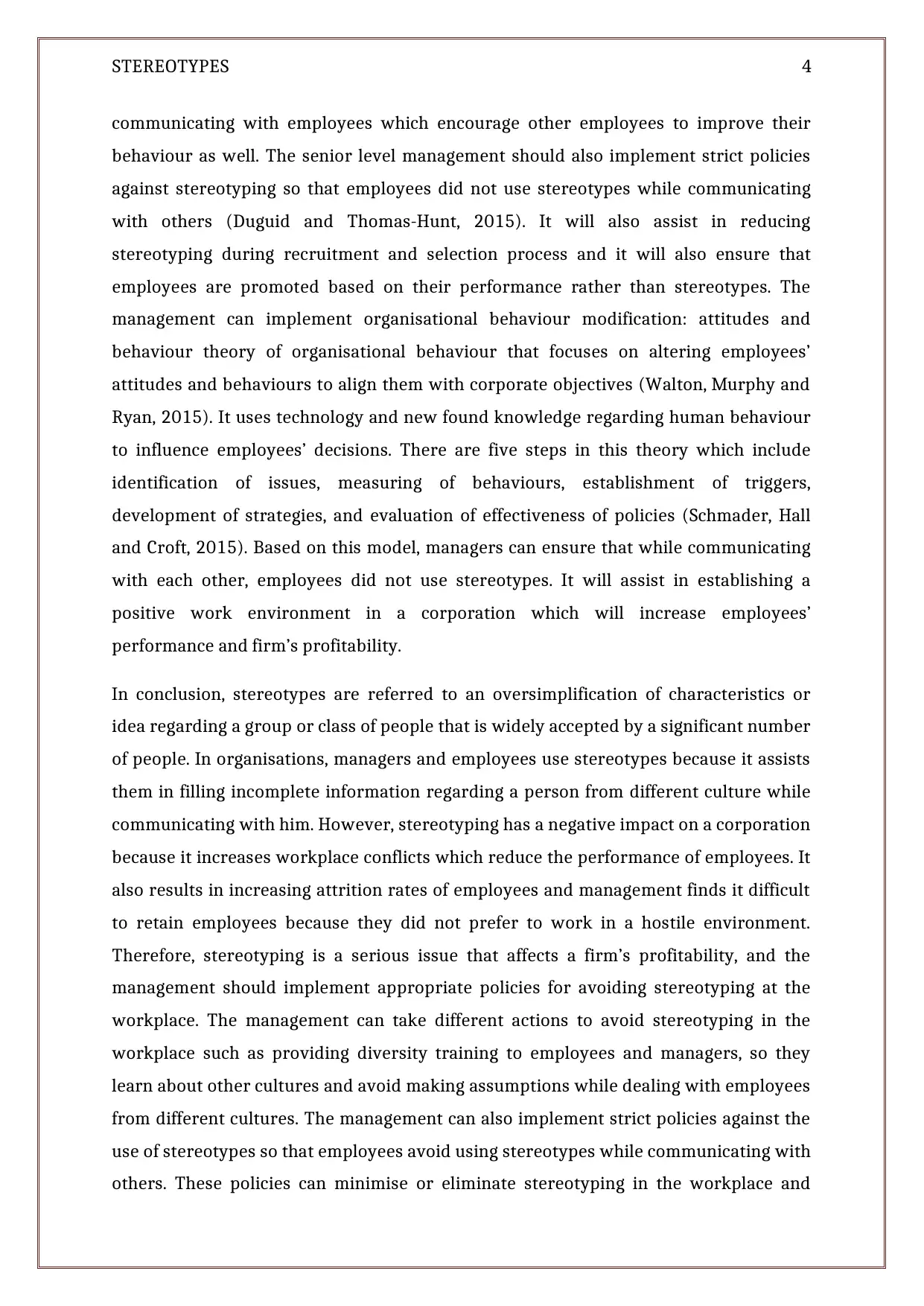
STEREOTYPES 4
communicating with employees which encourage other employees to improve their
behaviour as well. The senior level management should also implement strict policies
against stereotyping so that employees did not use stereotypes while communicating
with others (Duguid and Thomas-Hunt, 2015). It will also assist in reducing
stereotyping during recruitment and selection process and it will also ensure that
employees are promoted based on their performance rather than stereotypes. The
management can implement organisational behaviour modification: attitudes and
behaviour theory of organisational behaviour that focuses on altering employees’
attitudes and behaviours to align them with corporate objectives (Walton, Murphy and
Ryan, 2015). It uses technology and new found knowledge regarding human behaviour
to influence employees’ decisions. There are five steps in this theory which include
identification of issues, measuring of behaviours, establishment of triggers,
development of strategies, and evaluation of effectiveness of policies (Schmader, Hall
and Croft, 2015). Based on this model, managers can ensure that while communicating
with each other, employees did not use stereotypes. It will assist in establishing a
positive work environment in a corporation which will increase employees’
performance and firm’s profitability.
In conclusion, stereotypes are referred to an oversimplification of characteristics or
idea regarding a group or class of people that is widely accepted by a significant number
of people. In organisations, managers and employees use stereotypes because it assists
them in filling incomplete information regarding a person from different culture while
communicating with him. However, stereotyping has a negative impact on a corporation
because it increases workplace conflicts which reduce the performance of employees. It
also results in increasing attrition rates of employees and management finds it difficult
to retain employees because they did not prefer to work in a hostile environment.
Therefore, stereotyping is a serious issue that affects a firm’s profitability, and the
management should implement appropriate policies for avoiding stereotyping at the
workplace. The management can take different actions to avoid stereotyping in the
workplace such as providing diversity training to employees and managers, so they
learn about other cultures and avoid making assumptions while dealing with employees
from different cultures. The management can also implement strict policies against the
use of stereotypes so that employees avoid using stereotypes while communicating with
others. These policies can minimise or eliminate stereotyping in the workplace and
communicating with employees which encourage other employees to improve their
behaviour as well. The senior level management should also implement strict policies
against stereotyping so that employees did not use stereotypes while communicating
with others (Duguid and Thomas-Hunt, 2015). It will also assist in reducing
stereotyping during recruitment and selection process and it will also ensure that
employees are promoted based on their performance rather than stereotypes. The
management can implement organisational behaviour modification: attitudes and
behaviour theory of organisational behaviour that focuses on altering employees’
attitudes and behaviours to align them with corporate objectives (Walton, Murphy and
Ryan, 2015). It uses technology and new found knowledge regarding human behaviour
to influence employees’ decisions. There are five steps in this theory which include
identification of issues, measuring of behaviours, establishment of triggers,
development of strategies, and evaluation of effectiveness of policies (Schmader, Hall
and Croft, 2015). Based on this model, managers can ensure that while communicating
with each other, employees did not use stereotypes. It will assist in establishing a
positive work environment in a corporation which will increase employees’
performance and firm’s profitability.
In conclusion, stereotypes are referred to an oversimplification of characteristics or
idea regarding a group or class of people that is widely accepted by a significant number
of people. In organisations, managers and employees use stereotypes because it assists
them in filling incomplete information regarding a person from different culture while
communicating with him. However, stereotyping has a negative impact on a corporation
because it increases workplace conflicts which reduce the performance of employees. It
also results in increasing attrition rates of employees and management finds it difficult
to retain employees because they did not prefer to work in a hostile environment.
Therefore, stereotyping is a serious issue that affects a firm’s profitability, and the
management should implement appropriate policies for avoiding stereotyping at the
workplace. The management can take different actions to avoid stereotyping in the
workplace such as providing diversity training to employees and managers, so they
learn about other cultures and avoid making assumptions while dealing with employees
from different cultures. The management can also implement strict policies against the
use of stereotypes so that employees avoid using stereotypes while communicating with
others. These policies can minimise or eliminate stereotyping in the workplace and
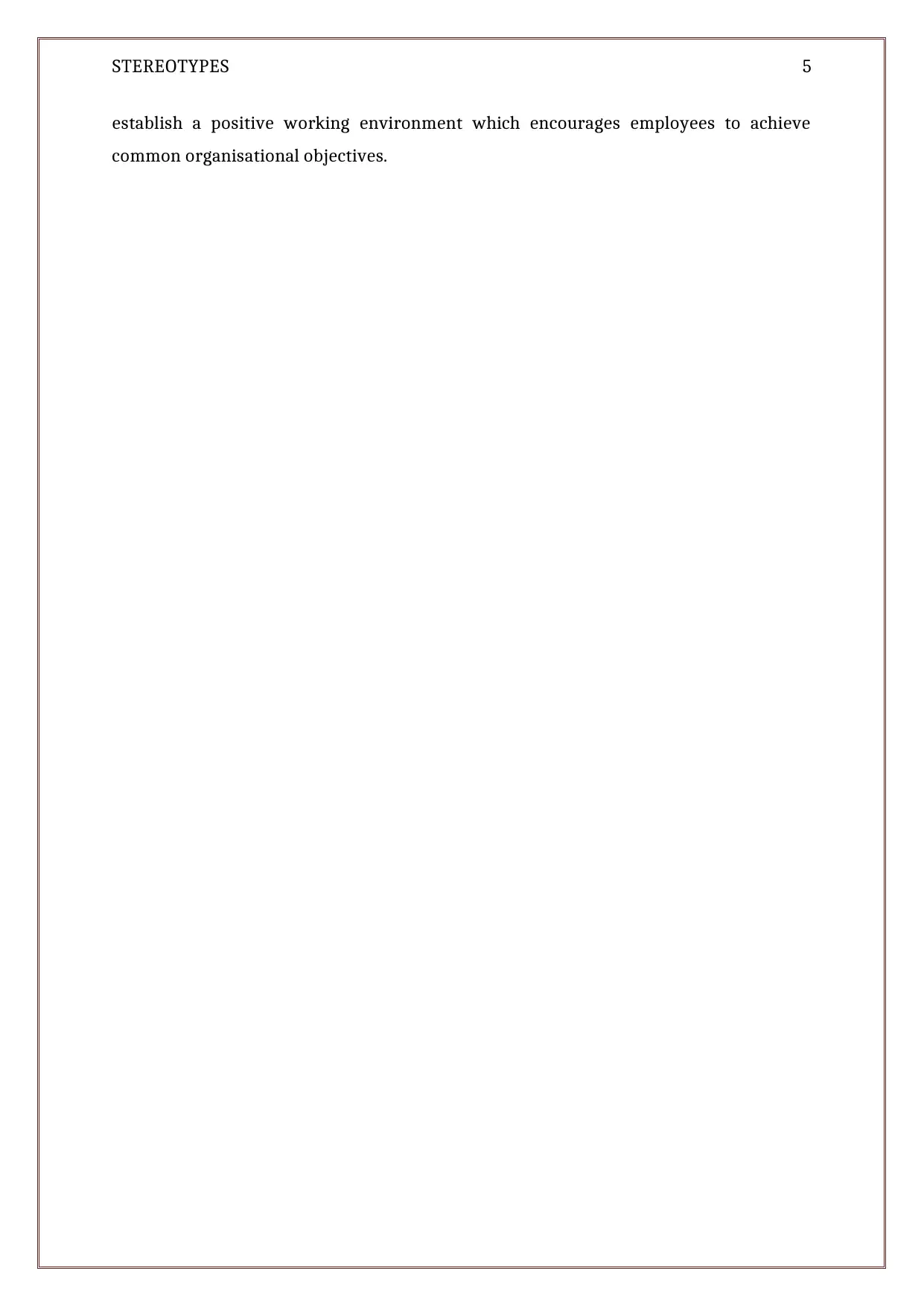
STEREOTYPES 5
establish a positive working environment which encourages employees to achieve
common organisational objectives.
establish a positive working environment which encourages employees to achieve
common organisational objectives.
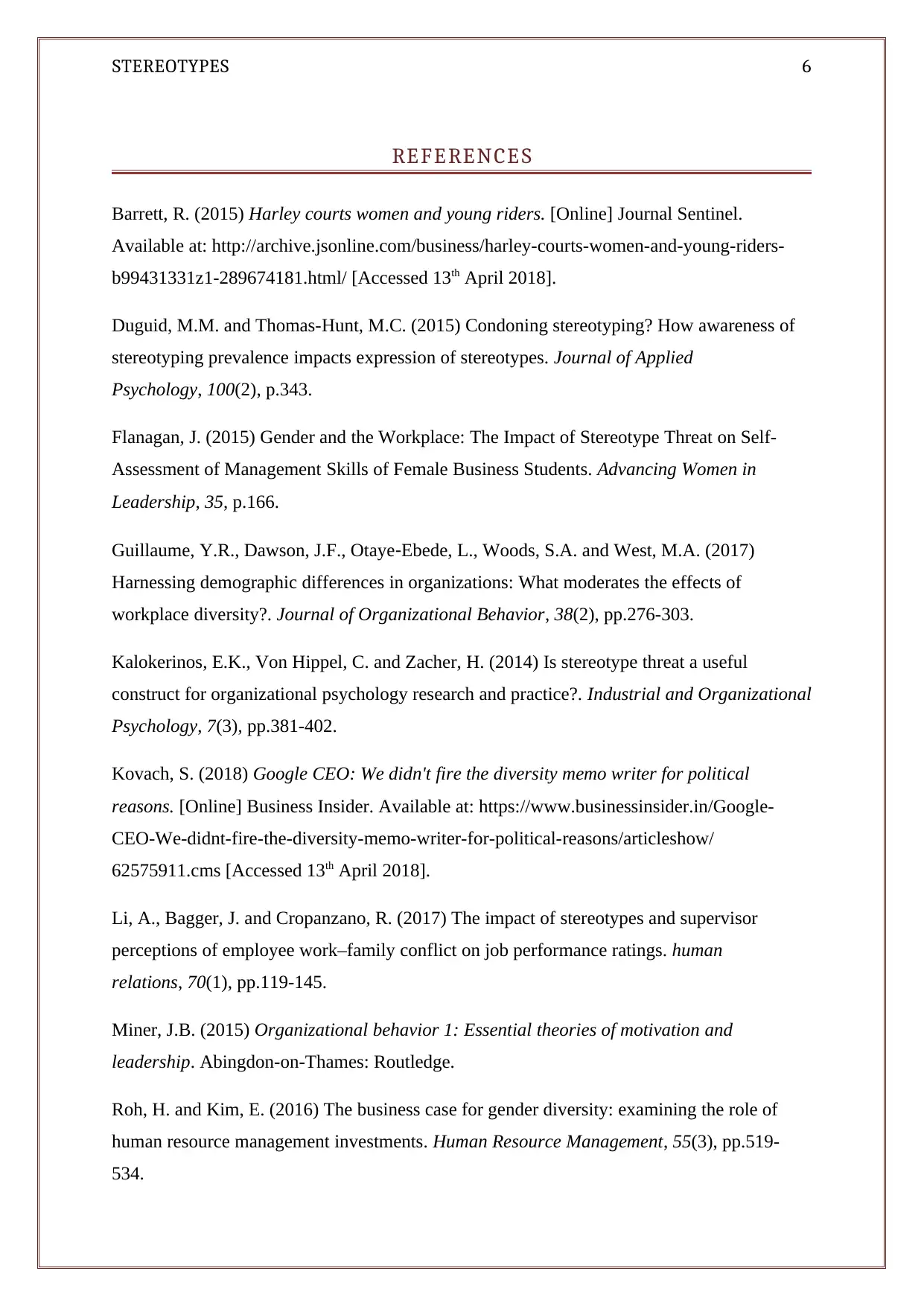
STEREOTYPES 6
REFERENCES
Barrett, R. (2015) Harley courts women and young riders. [Online] Journal Sentinel.
Available at: http://archive.jsonline.com/business/harley-courts-women-and-young-riders-
b99431331z1-289674181.html/ [Accessed 13th April 2018].
Duguid, M.M. and Thomas-Hunt, M.C. (2015) Condoning stereotyping? How awareness of
stereotyping prevalence impacts expression of stereotypes. Journal of Applied
Psychology, 100(2), p.343.
Flanagan, J. (2015) Gender and the Workplace: The Impact of Stereotype Threat on Self-
Assessment of Management Skills of Female Business Students. Advancing Women in
Leadership, 35, p.166.
Guillaume, Y.R., Dawson, J.F., Otaye‐Ebede, L., Woods, S.A. and West, M.A. (2017)
Harnessing demographic differences in organizations: What moderates the effects of
workplace diversity?. Journal of Organizational Behavior, 38(2), pp.276-303.
Kalokerinos, E.K., Von Hippel, C. and Zacher, H. (2014) Is stereotype threat a useful
construct for organizational psychology research and practice?. Industrial and Organizational
Psychology, 7(3), pp.381-402.
Kovach, S. (2018) Google CEO: We didn't fire the diversity memo writer for political
reasons. [Online] Business Insider. Available at: https://www.businessinsider.in/Google-
CEO-We-didnt-fire-the-diversity-memo-writer-for-political-reasons/articleshow/
62575911.cms [Accessed 13th April 2018].
Li, A., Bagger, J. and Cropanzano, R. (2017) The impact of stereotypes and supervisor
perceptions of employee work–family conflict on job performance ratings. human
relations, 70(1), pp.119-145.
Miner, J.B. (2015) Organizational behavior 1: Essential theories of motivation and
leadership. Abingdon-on-Thames: Routledge.
Roh, H. and Kim, E. (2016) The business case for gender diversity: examining the role of
human resource management investments. Human Resource Management, 55(3), pp.519-
534.
REFERENCES
Barrett, R. (2015) Harley courts women and young riders. [Online] Journal Sentinel.
Available at: http://archive.jsonline.com/business/harley-courts-women-and-young-riders-
b99431331z1-289674181.html/ [Accessed 13th April 2018].
Duguid, M.M. and Thomas-Hunt, M.C. (2015) Condoning stereotyping? How awareness of
stereotyping prevalence impacts expression of stereotypes. Journal of Applied
Psychology, 100(2), p.343.
Flanagan, J. (2015) Gender and the Workplace: The Impact of Stereotype Threat on Self-
Assessment of Management Skills of Female Business Students. Advancing Women in
Leadership, 35, p.166.
Guillaume, Y.R., Dawson, J.F., Otaye‐Ebede, L., Woods, S.A. and West, M.A. (2017)
Harnessing demographic differences in organizations: What moderates the effects of
workplace diversity?. Journal of Organizational Behavior, 38(2), pp.276-303.
Kalokerinos, E.K., Von Hippel, C. and Zacher, H. (2014) Is stereotype threat a useful
construct for organizational psychology research and practice?. Industrial and Organizational
Psychology, 7(3), pp.381-402.
Kovach, S. (2018) Google CEO: We didn't fire the diversity memo writer for political
reasons. [Online] Business Insider. Available at: https://www.businessinsider.in/Google-
CEO-We-didnt-fire-the-diversity-memo-writer-for-political-reasons/articleshow/
62575911.cms [Accessed 13th April 2018].
Li, A., Bagger, J. and Cropanzano, R. (2017) The impact of stereotypes and supervisor
perceptions of employee work–family conflict on job performance ratings. human
relations, 70(1), pp.119-145.
Miner, J.B. (2015) Organizational behavior 1: Essential theories of motivation and
leadership. Abingdon-on-Thames: Routledge.
Roh, H. and Kim, E. (2016) The business case for gender diversity: examining the role of
human resource management investments. Human Resource Management, 55(3), pp.519-
534.
Paraphrase This Document
Need a fresh take? Get an instant paraphrase of this document with our AI Paraphraser
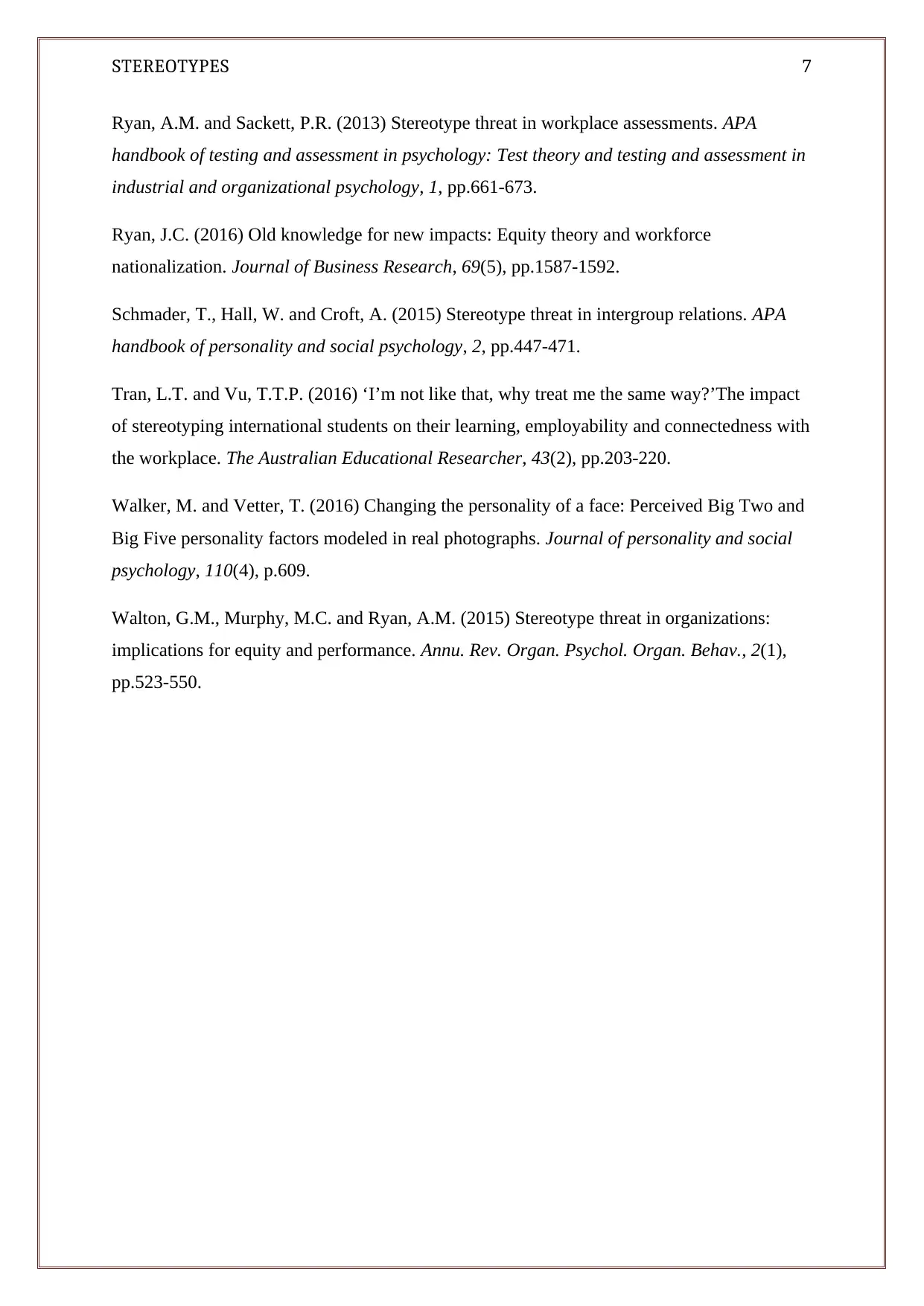
STEREOTYPES 7
Ryan, A.M. and Sackett, P.R. (2013) Stereotype threat in workplace assessments. APA
handbook of testing and assessment in psychology: Test theory and testing and assessment in
industrial and organizational psychology, 1, pp.661-673.
Ryan, J.C. (2016) Old knowledge for new impacts: Equity theory and workforce
nationalization. Journal of Business Research, 69(5), pp.1587-1592.
Schmader, T., Hall, W. and Croft, A. (2015) Stereotype threat in intergroup relations. APA
handbook of personality and social psychology, 2, pp.447-471.
Tran, L.T. and Vu, T.T.P. (2016) ‘I’m not like that, why treat me the same way?’The impact
of stereotyping international students on their learning, employability and connectedness with
the workplace. The Australian Educational Researcher, 43(2), pp.203-220.
Walker, M. and Vetter, T. (2016) Changing the personality of a face: Perceived Big Two and
Big Five personality factors modeled in real photographs. Journal of personality and social
psychology, 110(4), p.609.
Walton, G.M., Murphy, M.C. and Ryan, A.M. (2015) Stereotype threat in organizations:
implications for equity and performance. Annu. Rev. Organ. Psychol. Organ. Behav., 2(1),
pp.523-550.
Ryan, A.M. and Sackett, P.R. (2013) Stereotype threat in workplace assessments. APA
handbook of testing and assessment in psychology: Test theory and testing and assessment in
industrial and organizational psychology, 1, pp.661-673.
Ryan, J.C. (2016) Old knowledge for new impacts: Equity theory and workforce
nationalization. Journal of Business Research, 69(5), pp.1587-1592.
Schmader, T., Hall, W. and Croft, A. (2015) Stereotype threat in intergroup relations. APA
handbook of personality and social psychology, 2, pp.447-471.
Tran, L.T. and Vu, T.T.P. (2016) ‘I’m not like that, why treat me the same way?’The impact
of stereotyping international students on their learning, employability and connectedness with
the workplace. The Australian Educational Researcher, 43(2), pp.203-220.
Walker, M. and Vetter, T. (2016) Changing the personality of a face: Perceived Big Two and
Big Five personality factors modeled in real photographs. Journal of personality and social
psychology, 110(4), p.609.
Walton, G.M., Murphy, M.C. and Ryan, A.M. (2015) Stereotype threat in organizations:
implications for equity and performance. Annu. Rev. Organ. Psychol. Organ. Behav., 2(1),
pp.523-550.
1 out of 8
Related Documents
Your All-in-One AI-Powered Toolkit for Academic Success.
+13062052269
info@desklib.com
Available 24*7 on WhatsApp / Email
![[object Object]](/_next/static/media/star-bottom.7253800d.svg)
Unlock your academic potential
© 2024 | Zucol Services PVT LTD | All rights reserved.





